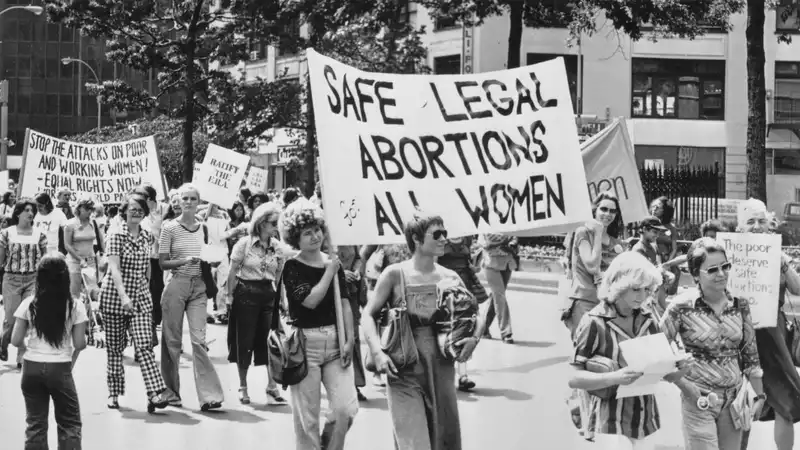Today is the 48th year of Law protection. Will this be the last?
On this day in 1973, the Supreme Court handed down its landmark decision on abortion rights, Roe v. Wade (opens in new tab). Citing the freedoms guaranteed by the Fourteenth Amendment, it was the first time in the world that the Constitution had ruled in favor of the right to abortion. In subsequent cases, the Court would make clear that this ability to make the most intimate and personal of decisions is central to women's dignity and to their equal participation in social, economic, and political life.
Landmark decisions never stand alone. Roe has its roots in a decades-old Supreme Court decision protecting personal decisions over the family. In the years that followed, the Court expanded its liberty rulings to encompass LGBTQ+ rights, including marriage equality and the right to intimacy. Most Americans benefit from these rights without being aware of their connection to Roe.
Not all descendants of Roe are blessed, however. In subsequent cases, the Supreme Court allowed states to pile on the burden of abortion care, leaving many behind, including those who rely on federal health care programs such as Medicaid.
The burden of abortion restrictions, even as the Supreme Court ruled in Roe, falls most heavily on those who already face multiple barriers to health care and other forms of discrimination, including BIPOC, youth, immigrants, LGBTQ+ people, rural people, and people working to make a living. Constitutional courts in other countries have complained of cruelty and discrimination in granting rights only to those with resources. For example, Nepal's Supreme Court ruled more than a decade ago (opens in new tab) that the government must establish a fund to pay for abortions for poor rural women and devote sufficient resources to meet the demand for abortion services and education.
Nevertheless, Roe has been an important bulwark against abortion bans and restrictions enacted in hundreds of states over the past decade: four years ago, the Court struck down a Texas law (opens in new tab) aimed at closing abortion clinics in the state. Last summer, in June Medical Services v. Russo (open in new tab), the Supreme Court struck down a law that mimicked Louisiana's abortion restrictions; in a close 5-4 decision, Chief Justice Roberts voted to uphold the precedent. And time and again, lower courts have relied on Roe precedent to strike down restrictions that continue unrelentingly, including prohibitions on when, how, and for what reasons a pregnancy may be terminated.
However, with the death of Justice Ruth Bader Ginsburg and the confirmation of her replacement, Justice Amy Coney Barrett (opens in new tab), the composition of the Supreme Court has changed since the June healthcare ruling. This signals a radical change in the federal courts under the Trump administration, with incredibly troubling implications for abortion. Judge Barrett's scholarly writings, rulings, and public advocacy have revealed his legal opinion that the U.S. Constitution does not protect an individual's freedom to make decisions about his or her reproductive health. Two other Trump-appointed justices, Brett Kavanaugh and Neil Gorsuch, have already voted to uphold restrictions on abortion and contraception.
We now face a new court, with six of the nine justices already ruling against abortion rights.
Earlier this month, in the first ruling on abortion since Judge Barrett was confirmed, the impact of this new calculation became clear. Because of the COVID-19 pandemic, even while the court itself was hearing arguments in the case remotely from home, these six justices, with records against abortion rights, have unduly They reinstated a callous and outdated FDA policy that unnecessarily requires people seeking medical abortions to go to a health center to pick up their medication in person (instead of receiving it in the mail) (opens in new tab). There are still more abortion cases in the court pipeline that could have a devastating impact on access to abortion.
The new Supreme Court is not the only threat at stake. A decade-long effort by anti-abortion state legislators has led to the repeal of nearly 500 laws and restrictions passed aimed at banning abortion. It has worked. Today, more than 90% of U.S. counties do not have a single abortion provider, and six states (open in new tab) have lost their last abortion clinic. In most of the South and Midwest, access to abortion is a right only in theory. And last year, elected officials in at least 10 states attempted to exploit the COVID-19 pandemic to deny access to essential, time-sensitive abortion care (open in new tab).
The Center for Reproductive Rights' (open in new tab) state-by-state online tool "What if Roe Fell" (open in new tab) clearly shows what would happen if Roe were overturned or weakened. In other words, almost half of the nation would lose access to abortion care.
Roe is in crisis, and frankly, due to its lack of protections, it has never been good enough. But there is a way forward. A federal legislative solution. But if we have learned anything from the nearly half-century of Roe, it is that equal access to abortion is central to a fair and just society.
That is why the Center for Reproductive Rights is calling on the 117th Congress to pass bold federal legislation. First, enact the Women's Health Protection Act (WHPA) (opens in new tab) to ensure that abortion care is free from medically unnecessary burdens and prohibitions that impede access and close clinics. We must also pass EACH Woman Act (opens in new tab) and repeal the discriminatory Hyde Amendment (opens in new tab).
These actions would transform abortion rights and access to abortion. Free from political interference and discrimination, we can move forward, not backward, closer to a world where all people can make their own decisions about their own pregnancies.
.






Comments